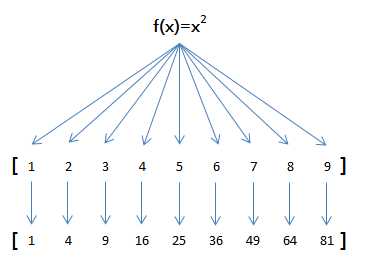Python函数式编程 map reduce filter
Posted
tags:
篇首语:本文由小常识网(cha138.com)小编为大家整理,主要介绍了Python函数式编程 map reduce filter相关的知识,希望对你有一定的参考价值。
函数式编程,使代码简洁高效。
Map函数:
map(func, *iterables),作用是将一个列表映射到另一个列表。

class map(object): """ map(func, *iterables) --> map object Make an iterator that computes the function using arguments from each of the iterables. Stops when the shortest iterable is exhausted. """
使用方法:
def f(x): return x**2 li = range(1,10) res = map(f,li) print(res) print(list(res)) """ <map object at 0x000000000117E2E8> [1, 4, 9, 16, 25, 36, 49, 64, 81] """

map(function, iterable, ...)
map()函数接收两个参数,一个是函数,一个是可迭代的对象,map将传入的函数依次作用到序列的每个元素,返回一个map对象,不是list。
基本等价于 [f(x) for x in interable],列表推导比map效率要高一些
map(lambda x: x+1, range(1, 3)) => [x+1 for x in range(1,3)]

str = ["far","foo","bar"] mp = map(lambda x:x.upper(),str) res = list(mp) print(res) """ [‘FAR‘, ‘FOO‘, ‘BAR‘] """
Reduce函数
reduce(function, sequence[, initial]),对可迭代对象依次做累计操作,如依次相加或相乘。
reduce()方法接收一个函数作为累加器(accumulator),数组中的每个值(从左到右)开始合并,最终为一个值。

def reduce(function, sequence, initial=None): # real signature unknown; restored from __doc__ """ reduce(function, sequence[, initial]) -> value Apply a function of two arguments cumulatively to the items of a sequence, from left to right, so as to reduce the sequence to a single value. For example, reduce(lambda x, y: x+y, [1, 2, 3, 4, 5]) calculates ((((1+2)+3)+4)+5). If initial is present, it is placed before the items of the sequence in the calculation, and serves as a default when the sequence is empty. """
直接使用会报错
reduce(lambda x, y : x + y, [1, 3, 5, 7, 9])
"""
NameError: name ‘reduce‘ is not defined
"""
正确的使用是:reduce是functools中的一个函数,需要引用:from functools import reduce
使用方法:
from functools import reduce res1 = reduce(lambda x, y: x*y, [1, 2, 3]) res2 = reduce(lambda x, y : x + y, [1, 3, 5]) print(res1) print(res2) """ 6 9 """
Filter函数
filter(function or None, iterable),作用是按照所定义的函数过滤掉列表中的一些元素

class filter(object): """ filter(function or None, iterable) --> filter object Return an iterator yielding those items of iterable for which function(item) is true. If function is None, return the items that are true. """
使用方法:
flt = filter(lambda x: x > 5, range(10)) res = list(flt) print(flt) print(res) """ <filter object at 0x0000000000649A58> [6, 7, 8, 9] """
以上是关于Python函数式编程 map reduce filter的主要内容,如果未能解决你的问题,请参考以下文章
